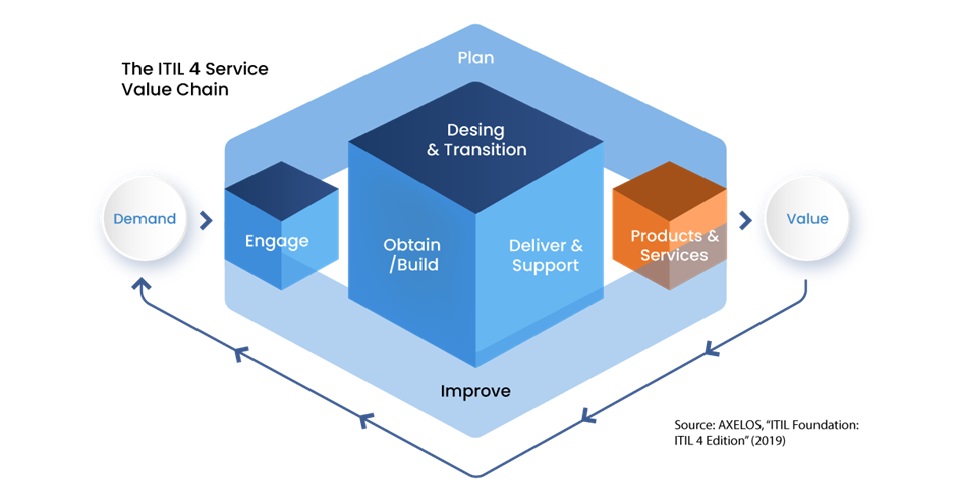Table of Contents
ToggleIn today’s fast-paced digital world, optimizing IT service management (ITSM) is crucial for businesses aiming to stay competitive. ITIL 4’s Service Value Chain (SVC) provides a comprehensive framework that helps organizations streamline their ITSM processes. This article explores strategies for leveraging the ITIL 4 Service Value Chain effectively, offering fresh perspectives and insights that will help your organization achieve optimal performance.
Introduction to ITIL 4 Service Value Chain
The ITIL 4 Service Value Chain is a central element of the ITIL 4 framework, which provides a structured approach to delivering valuable services to customers. The Service Value Chain consists of six key activities:
- Plan
- Improve
- Engage
- Design and Transition
- Obtain/Build
- Deliver and Support

These activities work together to transform inputs into valuable outputs, facilitating the creation, delivery, and continual improvement of services.
Strategies for Leveraging the Service Value Chain
1. Effective Planning and Strategy
High-Search Volume Keywords: ITIL 4 planning, service value chain strategy, ITIL 4 framework
Effective planning is the foundation of a successful ITIL 4 implementation. Start by clearly defining your organizational goals and aligning them with your ITSM objectives. Utilize the Plan activity to establish a clear vision, set achievable targets, and create a roadmap for implementation.
Key Steps:
- Conduct a thorough needs assessment to identify gaps and opportunities.
- Develop a detailed ITSM strategy that aligns with business objectives.
- Allocate resources efficiently to support the plan.
2. Continuous Improvement Culture
High-Search Volume Keywords: ITIL 4 continuous improvement, service value chain improvement, ITIL 4 optimization
Continuous improvement is integral to the ITIL 4 framework. Encourage a culture of constant evaluation and enhancement by leveraging the Improve activity. This involves regular performance reviews, feedback loops, and proactive problem-solving.
Key Steps:
- Implement a continuous improvement plan that includes regular performance assessments.
- Use metrics and KPIs to measure success and identify areas for improvement.
- Foster a culture that encourages feedback and innovation.
Table: Continuous Improvement Metrics
| Metric | Description | Target Value |
|---|---|---|
| Incident Resolution Time | Average time to resolve incidents | < 1 hour |
| Customer Satisfaction | Customer feedback on service quality | > 90% |
| Change Success Rate | Percentage of successful changes implemented | > 95% |
3. Engaging Stakeholders Effectively
High-Search Volume Keywords: ITIL 4 stakeholder engagement, ITIL 4 collaboration, service value chain engagement
Engaging stakeholders is crucial for the successful implementation of ITIL 4. Utilize the Engage activity to build strong relationships with all stakeholders, including customers, employees, and partners.
Key Steps:
- Identify and map key stakeholders and their roles.
- Develop communication strategies tailored to different stakeholder groups.
- Regularly update stakeholders on progress and gather feedback.
4. Design and Transition Best Practices
High-Search Volume Keywords: ITIL 4 design and transition, service design, ITIL 4 implementation
The Design and Transition activity ensures that services are effectively designed and transitioned into live environments. Focus on designing services that meet both current and future needs, and manage transitions smoothly to minimize disruptions.
Key Steps:
- Use a structured approach to service design that includes user requirements and business objectives.
- Develop a transition plan that includes testing, training, and communication.
- Monitor and manage risks associated with transitions.
5. Efficient Resource Management
High-Search Volume Keywords: ITIL 4 resource management, obtain/build, ITIL 4 tools
Resource management is vital for obtaining and building the necessary components for service delivery. The Obtain/Build activity focuses on sourcing, building, and managing resources efficiently.
Key Steps:
- Identify the resources needed for service delivery, including technology, people, and processes.
- Implement efficient procurement and build processes.
- Regularly review resource utilization to ensure optimal performance.
Table: Resource Management Checklist
| Resource Type | Description | Management Strategy |
|---|---|---|
| Human | Staff and skillsets | Training and development programs |
| Technological | Tools and software | Regular upgrades and maintenance |
| Financial | Budget and costs | Efficient allocation and monitoring |
6. Delivering and Supporting Services
High-Search Volume Keywords: ITIL 4 service delivery, ITIL 4 support, IT service management
The Deliver and Support activity focuses on ensuring that services are delivered as planned and supported effectively. This involves monitoring service performance, managing incidents, and ensuring customer satisfaction.
Key Steps:
- Implement robust monitoring and reporting mechanisms.
- Develop an efficient incident management process.
- Focus on customer service and support to enhance satisfaction.
Case Study: Successful ITIL 4 Implementation
Organization: ABC Corp
Challenge: ABC Corp struggled with inefficient IT service management processes, leading to frequent outages and low customer satisfaction.
Solution: By implementing ITIL 4’s Service Value Chain, ABC Corp streamlined its ITSM processes. They started with effective planning, engaged stakeholders, and focused on continuous improvement. They also optimized resource management and ensured smooth service delivery and support.
Results:
- Reduced incident resolution time by 40%
- Increased customer satisfaction by 30%
- Improved overall service efficiency and performance
Conclusion
Leveraging ITIL 4’s Service Value Chain effectively can transform your organization’s IT service management processes. By focusing on strategic planning, continuous improvement, stakeholder engagement, efficient resource management, and robust service delivery and support, you can achieve optimal performance and deliver exceptional value to your customers.
Additional Resources
- ITIL 4 Foundation Certification Guide
- Best Practices for ITIL 4 Implementation
- Continuous Improvement in ITSM: A Practical Approach
By adopting these strategies and focusing on the key activities of the Service Value Chain, your organization can navigate ITIL 4 successfully and reap the benefits of improved ITSM processes. Successfully training your workforce in the ITIL 4 Foundation course helps an organization to successfully navigate ITIL 4’s service value chain for optimal performance. Spoclearn is an AXELOS/PeopleCert Accredited Training Organization (ATO) to deliver ITIL 4 training worldwide across industry sectors.
Table: ITIL 4 Service Value Chain Activities Overview
| Activity | Description | Key Benefits |
|---|---|---|
| Plan | Establishing strategic direction and setting objectives | Clear vision and strategic alignment |
| Improve | Ongoing evaluation and enhancement of services | Continuous improvement and innovation |
| Engage | Building strong relationships with stakeholders | Improved collaboration and communication |
| Design and Transition | Designing and transitioning new or changed services | Effective service design and seamless transitions |
| Obtain/Build | Sourcing and building necessary service components | Efficient resource management and procurement |
| Deliver and Support | Ensuring effective service delivery and support | High customer satisfaction and service quality |
By following these best practices and utilizing the provided tables and metrics, your organization can effectively leverage the ITIL 4 Service Value Chain to achieve optimal performance and deliver exceptional value to your customers.
Read New Blog on ITIL4 – ITIL 4 and Security Management: Ensuring Robust Information Security
